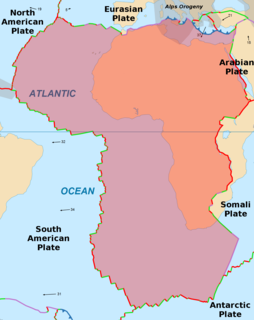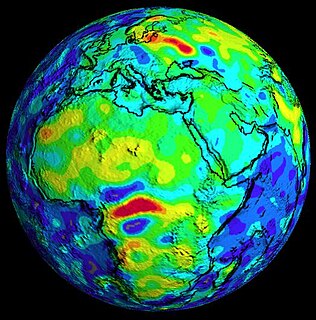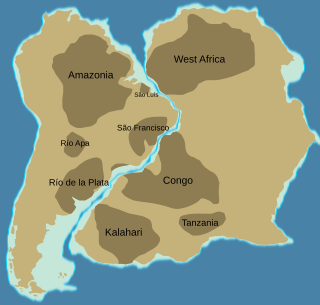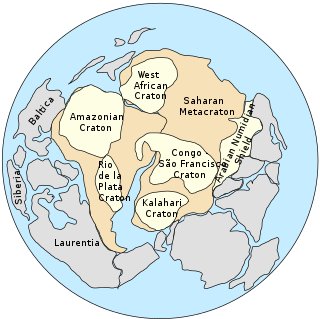 W
WThe African Plate is a major tectonic plate straddling the Equator as well as the prime meridian. It includes much of the continent of Africa, as well as oceanic crust which lies between the continent and various surrounding ocean ridges. Between 60 million years ago and 10 million years ago, the Somali Plate began rifting from the African Plate along the East African Rift. Since the continent of Africa consists of crust from both the African and the Somali plates, some literature refers to the African Plate as the Nubian Plate to distinguish it from the continent as a whole.
 W
WThe Arabian Plate is a minor tectonic plate in the northern and eastern hemispheres.
 W
WThe Aswa Dislocation, also called the Aswa mylonite belt, Aswa Lineament or Aswa Shear Zone is a north-west trending ductile shear zone that runs to the east of Lake Victoria in East Africa.
 W
WThe Bangui magnetic anomaly is a local variation in the Earth's magnetic field centered at Bangui, the capital of Central African Republic. The magnetic anomaly is roughly elliptical, about 700 km × 1,000 km, and covers most of the country, making it one of the "largest and most intense crustal magnetic anomalies on the African continent". The anomaly was discovered in the late 1950s, explored in the 1970s, and named in 1982. Its origin remains unclear.
 W
WThe Benue Trough is a major geological structure underlying a large part of Nigeria and extending about 1,000 km northeast from the Bight of Benin to Lake Chad. It is part of the broader West and Central African Rift System.
 W
WThe Blue Nile rift is a major geological formation in the Sudan, a rift with a NW trend that terminates on the Central African Shear Zone. It was formed through crustal extension during the break-up of Gondwana.
 W
WThe Central African Shear Zone (CASZ) is a wrench fault system extending in an ENE direction from the Gulf of Guinea through Cameroon into Sudan. The structure is not well understood. As of 2008, there was still no general agreement about how the individual shears along the lineament link up.
 W
WThe Congo Craton, covered by the Palaeozoic-to-recent Congo Basin, is an ancient Precambrian craton that with four others makes up the modern continent of Africa. These cratons were formed between about 3.6 and 2.0 billion years ago and have been tectonically stable since that time. All of these cratons are bounded by younger fold belts formed between 2.0 billion and 300 million years ago.
 W
WThe Copperbelt is a natural region in Central Africa which sits on the border region between northern Zambia and the southern Democratic Republic of Congo. It is known for copper mining.
 W
WThe Gibraltar Arc is a geological region corresponding to an arcuate orogen surrounding the Alboran Sea, between the Iberian Peninsula and Africa. It consists of the Betic Cordillera, and the Rif. The Gibraltar Arc is located at the western end of the Mediterranean Alpine belt and formed during the Neogene due to convergence of the Eurasian and African plates.
 W
WGondwana or Gondwanaland was a supercontinent that existed from the Neoproterozoic and began to break up during the Jurassic, with the opening of the Drake Passage, separating South America and Antarctica occurring during the Eocene. Gondwana was not considered a supercontinent by the earliest definition, since the landmasses of Baltica, Laurentia, and Siberia were separated from it.
 W
WThe Great Rift Valley is a series of contiguous geographic trenches, approximately 7,000 kilometres (4,300 mi) in total length, that runs from the Beqaa Valley in Lebanon which is in Asia to Mozambique in Southeast Africa. While the name continues in some usages, it is rarely used in geology as it is considered an imprecise merging of separate though related rift and fault systems.
 W
WThe Lufilian Arc is part of a system of orogenic belts in southern Africa formed during the Pan-African orogeny, a stage in the formation of the Gondwana supercontinent. It extends across eastern Angola, the Katanga Province of the southern Democratic Republic of the Congo and the northwest of Zambia. The arc is about 800 kilometres (500 mi) long. It has global economic importance owing to its rich deposits of copper and cobalt.
 W
WThe Man Shield is a geological shield or craton in the southeast portion of the West African Craton. The shield is in part overlaid by gold-bearing Birimian formations.
 W
WThe Nubian Swell is a geologic structural uplift in northern Africa that trends east-west and separates the lower Nile of Egypt from the Sudan basin. The Nubian Swell has been geologically active since early Mesozoic times, and portions are still active. The Nile traverses the uplift through geologic fractures and faults, and four of six cataracts of the Nile occur where the river crosses the uplift.
 W
WThe Saharan Metacraton is a term used by some geologists to describe a large area of continental crust in the north-central part of Africa. Whereas a craton is an old and stable part of the lithosphere, the term "metacraton" is used to describe a craton that has been remobilized during an orogenic event, but where the characteristics of the original craton are still identifiable. The geology of the continent has only been partially explored, and other names have been used to describe the general area that reflect different views of its nature and extent. These include "Nile Craton", "Sahara Congo Craton", "Eastern Saharan Craton" and "Central Saharan Ghost Craton". This last term is because the older rocks are almost completely covered by recent sediments and desert sands, making geological analysis difficult.
 W
WThe Seychelles Microcontinent is a microcontinent underlying Seychelles in the western Indian Ocean made of Late Precambrian rock.
 W
WThe Somali Plate is a minor tectonic plate which straddles the Equator in the Eastern Hemisphere. It is approximately centered on the island of Madagascar and includes about half of the east coast of Africa, from the Gulf of Aden in the north through the East African Rift Valley. The southern boundary with the Nubian-African Plate is a diffuse plate boundary consisting of the Lwandle Plate.
 W
WThe Tuareg Shield is a geological formation lying between the West African craton and the Saharan Metacraton in West Africa. Named after the Tuareg people, it has complex a geology, reflecting the collision between these cratons and later events. The landmass covers parts of Algeria, Niger and Mali.
 W
WThe greater Turkana Basin in East Africa determines a large endorheic basin, a drainage basin with no outflow centered around the north-southwards directed Gregory Rift system in Kenya and southern Ethiopia. The deepest point of the basin is the endorheic Lake Turkana, a brackish Soda lake with a very high ecological productivity in the Gregory Rift.
 W
WThe Victoria Microplate or Victoria Plate is a small tectonic plate in East Africa. It is bounded on all sides by parts of the active East African Rift System. It is currently rotating anticlockwise. Its boundaries are close to those of the mainly Archaean Tanzania Craton, with the two arms of the rift system having propagated along the surrounding Proterozoic shear belts. To the northwest, west and southwest it has a boundary with the Nubian Plate, to the northeast and east with the Somali Plate and to the southeast with the Rovuma Plate.
 W
WThe White Nile rift is one of several rifts in central Sudan running in a NW direction and terminating in the Central African Shear Zone. The rift is a Cretaceous/Tertiary structure that has similar tectonic characteristics to the Southern Sudan Rift, Blue Nile rift and Atbara rift. These rifts follow similar trends, and terminate in a line at their northwestern ends. Probably this line is an extension of the Central African Shear Zone through the Sudan.